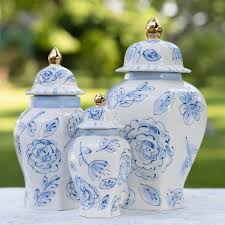Ginger Jar: The Timeless Elegance of Traditional Chinese Porcelain
Exploring the History, Design, and Modern Appeal of Ginger Jars

The ginger jar, an iconic piece of Chinese porcelain, embodies centuries of tradition, artistry, and functionality. Renowned for its distinct shape, intricate designs, and rich history, the ginger jar has transcended its original purpose of spice storage to become a coveted decorative item worldwide. With its timeless appeal and versatility, the ginger jar continues to captivate collectors and design enthusiasts alike.
The Historical Origins of Ginger Jars
The ginger jar traces its origins to ancient China, where it was initially created during the Tang Dynasty (618–907 AD). These jars were primarily used for storing and transporting spices, oils, and other valuable goods, including the spice from which they derive their name — ginger. During the Ming Dynasty (1368–1644 AD), ginger jars gained prominence not only for their practicality but also for their aesthetic allure. Artisans began decorating these jars with intricate patterns, often using the iconic blue-and-white porcelain style that remains popular today.
As trade routes expanded, ginger jars became prized exports to Europe, where they symbolized luxury and sophistication. Their timeless design and cultural significance have since cemented their place as a hallmark of Chinese porcelain.
Distinctive Design Features of Ginger Jars
The unique design of a ginger jar sets it apart from other porcelain items. Characterized by a rounded body, broad shoulders, a narrow neck, and a domed lid, the ginger jar is both functional and elegant. The lids are often snugly fitted to preserve the contents inside, showcasing the jar’s original purpose as a storage vessel.
Ginger jars are typically adorned with hand-painted motifs that reflect traditional Chinese art and symbolism. Common patterns include:
Floral Designs
Peonies, chrysanthemums, and plum blossoms represent beauty, prosperity, and resilience.
Mythical Creatures
Dragons and phoenixes symbolize power, good fortune, and harmony.
Landscapes
Scenes of mountains, rivers, and pagodas evoke tranquility and connection to nature.
The classic blue-and-white color palette remains the most recognizable, though other color combinations like red-and-gold or multicolored designs have also gained popularity over the centuries.
The Cultural Significance of Ginger Jars
Beyond their decorative appeal, ginger jars hold deep cultural significance in Chinese traditions. These jars often symbolize abundance and good fortune, making them popular gifts for weddings, anniversaries, and other celebrations. In Feng Shui, ginger jars are believed to attract positive energy and prosperity when placed strategically within a home.
The symbolism embedded in their designs adds another layer of meaning. For example, a jar featuring koi fish represents perseverance and success, while a jar adorned with lotus flowers signifies purity and enlightenment.
Modern Uses of Ginger Jars in Home Decor
Today, ginger jars have evolved from their utilitarian roots to become versatile decorative pieces. Their timeless design seamlessly integrates into various interior styles, from traditional to contemporary. Here are some creative ways to use ginger jars in modern home decor:
Standalone Accent Pieces
Display a single ginger jar on a console table or mantle for an elegant focal point.
Grouped Arrangements
Arrange a collection of jars in varying sizes and patterns to create a striking visual display.
Floral Vases
Remove the lid and use the jar to hold fresh or dried flowers, adding a touch of natural beauty.
Lamp Bases
Transform a ginger jar into a unique and stylish lamp for added functionality.
Table Centerpieces
Incorporate ginger jars into dining table settings for a sophisticated and culturally inspired look.
The adaptability of ginger jars ensures they remain a favorite among interior designers and homeowners seeking to add a touch of elegance to their spaces.
Tips for Selecting and Caring for Ginger Jars
When choosing a ginger jar, consider the following factors to ensure it complements your decor and meets your needs:
Design and Color
Opt for a pattern and color scheme that aligns with your interior style.
Size
Select a size appropriate for the intended placement, whether it’s a small accent piece or a large statement jar.
Authenticity
Look for quality craftsmanship and hand-painted details to ensure you’re purchasing an authentic piece.
To maintain the beauty of your ginger jars, follow these care tips:
Cleaning
Wipe gently with a soft, damp cloth to remove dust and dirt. Avoid harsh chemicals that may damage the glaze or paint.
Placement
Keep jars away from direct sunlight and extreme temperatures to prevent fading or cracking.
Storage
If not on display, store ginger jars in a safe and secure location to avoid accidental damage.
Why Ginger Jars Are a Timeless Addition to Any Collection
The enduring appeal of ginger jars lies in their ability to blend functionality with artistry. Whether used as a practical storage vessel in ancient times or as a decorative centerpiece in modern homes, ginger jars embody a rich history and timeless elegance that transcends cultural and generational boundaries. Their intricate designs, cultural significance, and versatility make them a cherished addition to any collection.
Conclusion
Ginger jars are more than just decorative objects; they are a testament to centuries of craftsmanship, cultural exchange, and artistic expression. From their humble beginnings as storage containers to their status as coveted collectibles, these iconic porcelain pieces continue to captivate and inspire. Whether you’re an avid collector or simply looking to add a touch of sophistication to your home, the ginger jar remains a timeless symbol of beauty and tradition.



